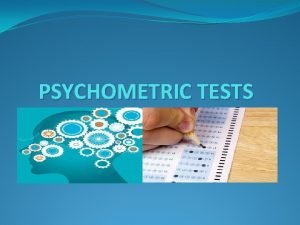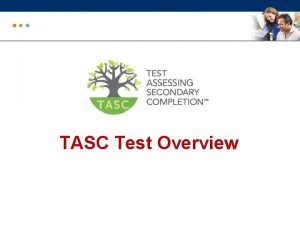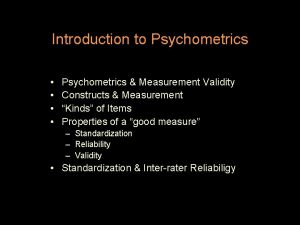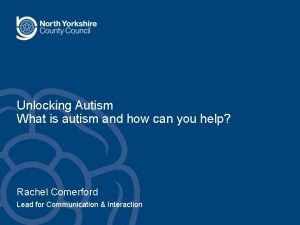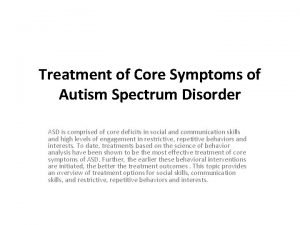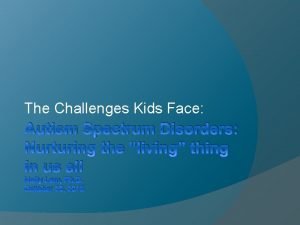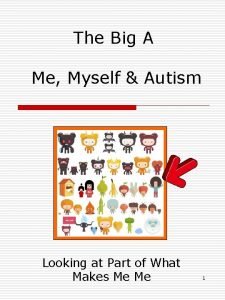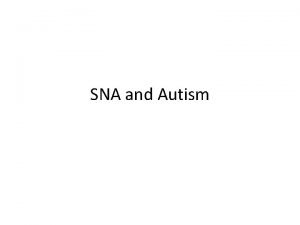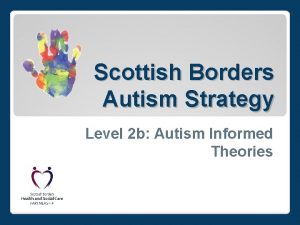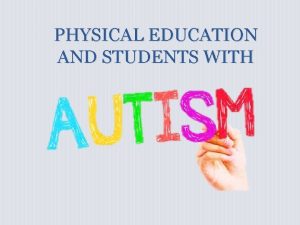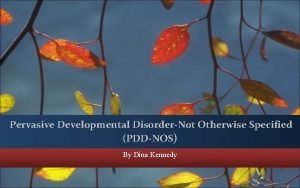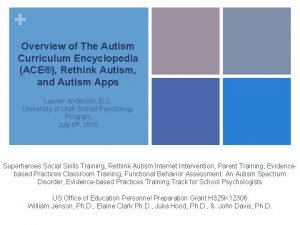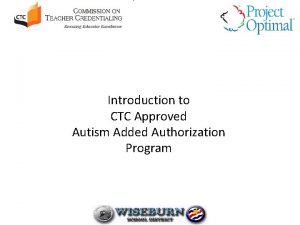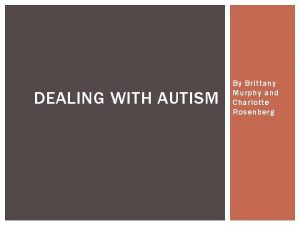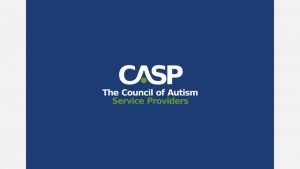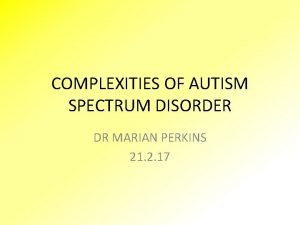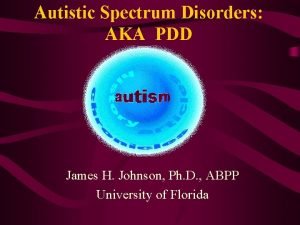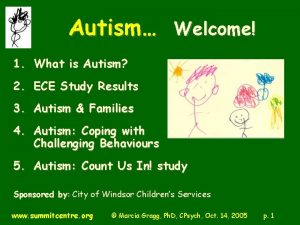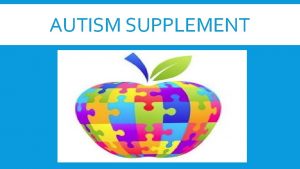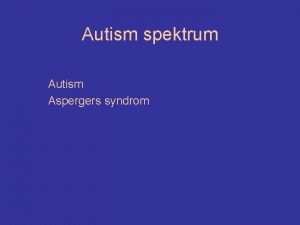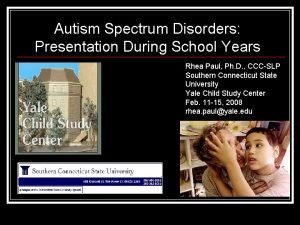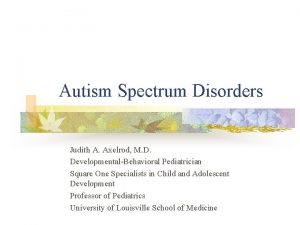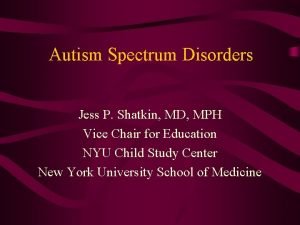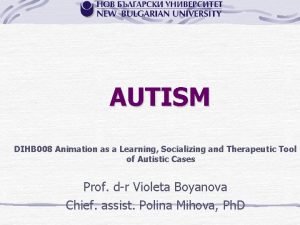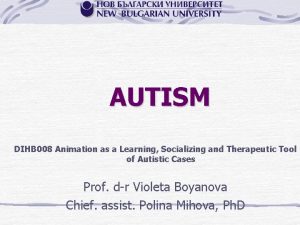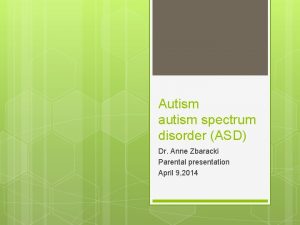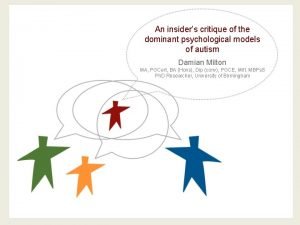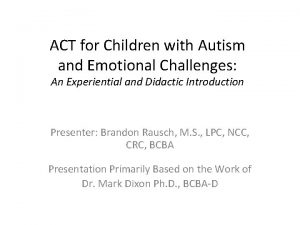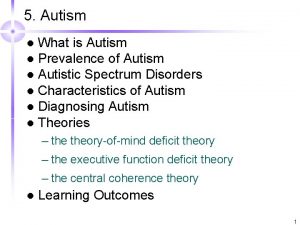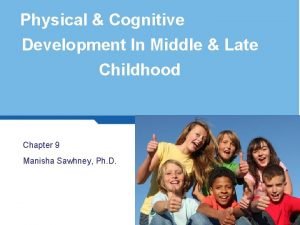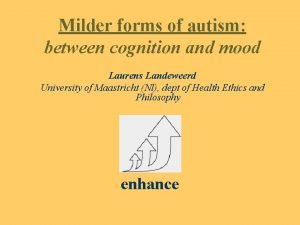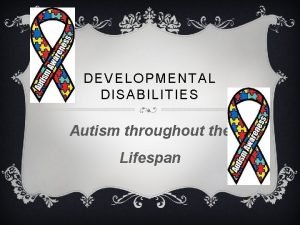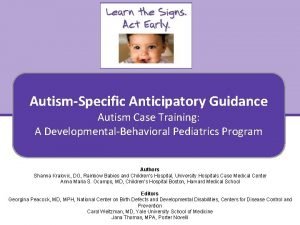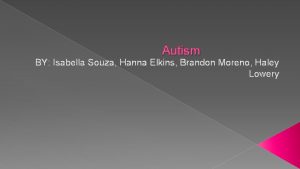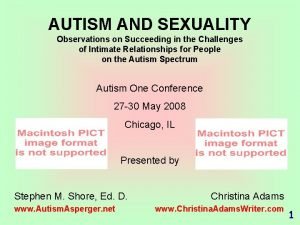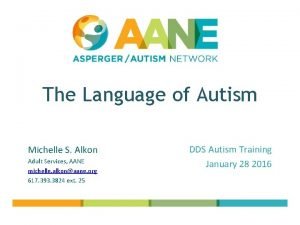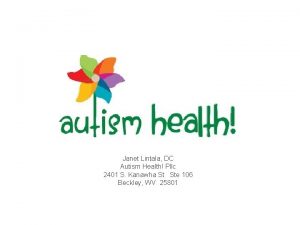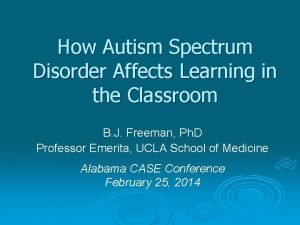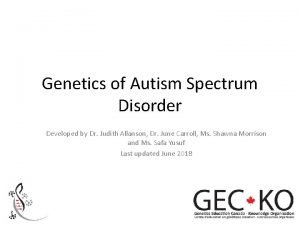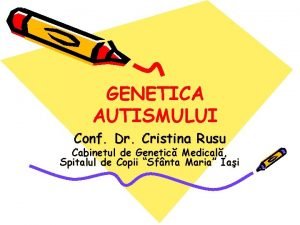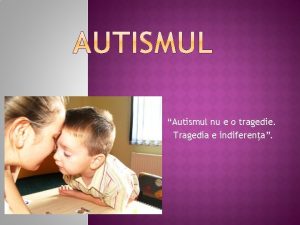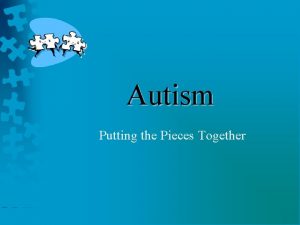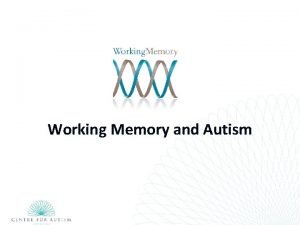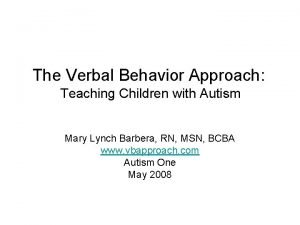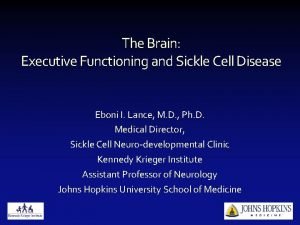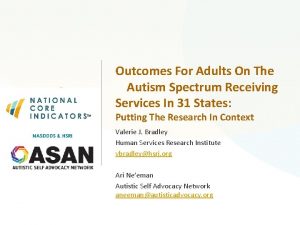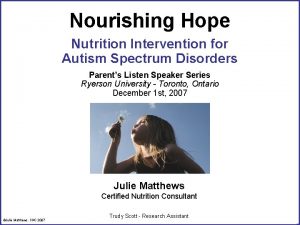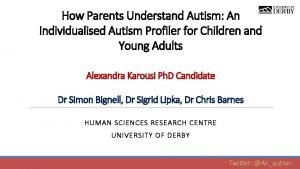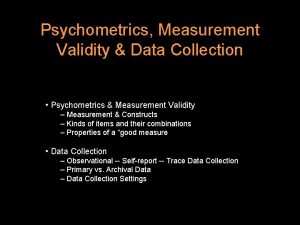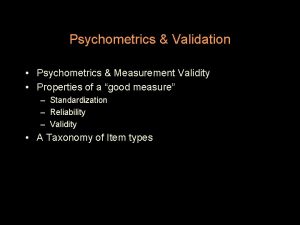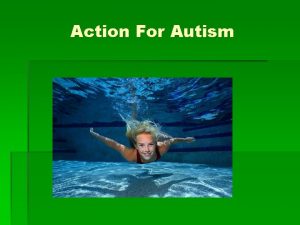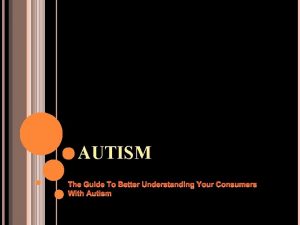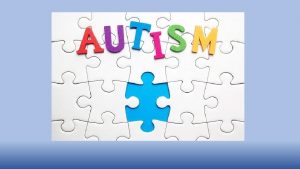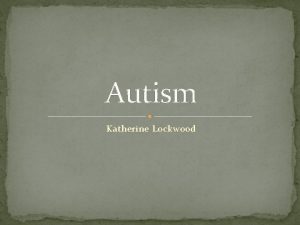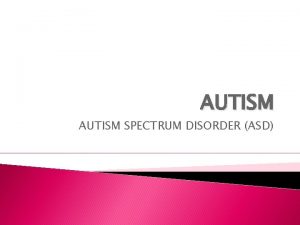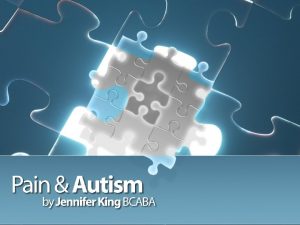Autism Identification From Psychometrics to Systems Autism Identification
















































































- Slides: 80

Autism Identification: From Psychometrics to Systems

Autism Identification: From Psychometrics to Systems (and Social Supports)

Developmental Disabilities l Conditions characterized by – Atypical development l l l Cognitive Motor Social-emotional

Autism Spectrum l Condition characterized by – – Atypical communication/socialization Repetitive/perseverative behaviors, interests

How Prevalent? • • 1 in 6 (~17%) children have a developmental disability or delay (DD) (CDC, 2011; National Survey of Children’s Health) 1 in 68 (~1. 5%) have an autism spectrum disorder (CDC, 2014; Autism and Developmental Disability Monitoring Network)

What is developmental monitoring and screening? l Developmental surveillance/ monitoring (AAP, 2006) – Longitudinal process

What is developmental monitoring and screening? l Developmental surveillance/ monitoring (AAP, 2006) – – Longitudinal process Ask/listen to parent concerns

What is developmental monitoring and screening? l Developmental surveillance/ monitoring (AAP, 2006) – – – Longitudinal process Ask/listen to parent concerns Developmental record

What is developmental monitoring and screening? l Developmental surveillance/ monitoring (AAP, 2006) – – Longitudinal process Ask/listen to parent concerns Developmental record Developmental observations

What is developmental monitoring and screening? l Developmental surveillance/ monitoring (AAP, 2006) – – – Longitudinal process Ask/listen to parent concerns Developmental record Developmental observations Look for risk/protective factors

What is developmental monitoring and screening? l Developmental surveillance/ monitoring (AAP, 2006) – – – Longitudinal process Ask/listen to parent concerns Developmental record Developmental observations Look for risk/protective factors Document

What is developmental monitoring and screening? l Developmental surveillance/ monitoring (AAP, 2006) – – – Longitudinal process Ask/listen to parent concerns Developmental record Developmental observations Look for risk/protective factors Document l Professionals (e. g. , physicians)

What is developmental monitoring and screening? l Developmental surveillance/monitoring (Barger, Rice, Simmons, & Wolf, 2016) – – – Cultural change/awareness LTSAE Advocacy

What is developmental monitoring and screening? l Developmental surveillance/monitoring (Barger, Rice, Simmons, & Wolf, 2016) – – – Cultural change/awareness LTSAE Advocacy l l Professionals (e. g. , physicians) Caretakers Early childcare providers Community members (YMCA)

What is developmental monitoring and screening? l Autism/Developmental screening (Macy, 2012; Robins et al. , 2014) – – Provision of brief instrument/questionnaire to identify children at risk of autism or developmental disabilities Typically given by health care professionals

Why increase monitoring and screening? • 1 in 6 (~17%) children have a developmental disability (DD) (CDC, 2011; National Survey of Children’s Health)

Why increase monitoring and screening? • • l 1 in 6 (~17%) children have a developmental disability (DD) (CDC, 2011; National Survey of Children’s Health) 1 in 68 (~1. 5%) have an autism spectrum disorder (CDC, 2014; Autism and Developmental Disability Monitoring Network)

Why increase monitoring and screening? • • • 1 in 6 (~17%) children have a developmental disability (DD) (CDC, 2011; National Survey of Children’s Health) 1 in 68 (~1. 5%) have an autism spectrum disorder (CDC, 2014; Autism and Developmental Disability Monitoring Network) Only 30% of children with DD identified before Kindergarten • 2 nd grade influx

Why increase monitoring and screening? • • 1 in 6 (~17%) children have a developmental disability (DD) (CDC, 2011; National Survey of Children’s Health) 1 in 68 (~1. 5%) have an autism spectrum disorder (CDC, 2014; Autism and Developmental Disability Monitoring Network) Only 30% of children with DD identified before Kindergarten Early intervention requires early identification

Does screening/surveillance work? l Policy recommendations for developmental screening primarily based on availability of valid developmental screeners (APA, 2006)

Does screening/surveillance work? l Policy recommendations for developmental screening primarily based on availability of valid developmental screeners (AAP, 2006) – Developmental screeners are tools designed to identify children at risk of autism and/or developmental disabilities/delays

Does screening/surveillance work? l Policy recommendations for developmental screening primarily based on availability of valid developmental screeners (AAP, 2006) – – Developmental screeners are tools Developmental surveillance/screening is a process

Does screening/surveillance work? l Policy recommendations for developmental screening primarily based on availability of valid developmental screeners (AAP, 2006) – – Developmental screeners: tools Developmental surveillance/screening: process l LIMITED EVIDENCE IN RELATION TO EARLY INTERVENTION IDENTIFICATION

What does this process look like? l Consider the Individuals with Disabilities Act (IDEA) Part C (IDEA, 2004; PL 108 -466) – 0 -3 early intervention system

What does this process look like? l Consider the Individuals with Disabilities Act (IDEA) Part C (IDEA, 2004; PL 108 -466) – l 0 -3 early intervention system Part C Early Intervention Process Includes – Monitoring (i. e. , Child Find)

What does this process look like? l Consider the Individuals with Disabilities Act (IDEA) Part C (IDEA, 2004; PL 108 -466) – l 0 -3 early intervention system Part C Early Intervention Process Includes – – Monitoring (i. e. , Child Find) Evaluation Assessment Referral

What does this process look like? l Consider the Individuals with Disabilities Act (IDEA) Part C (IDEA, 2004; PL 108 -466) – l 0 -3 early intervention system Part C Early Intervention Process Includes – – – Monitoring (i. e. , Child Find) Evaluation Assessment Referral Evaluation Assessment and Eligibility Determination

What does this process look like? l Consider the Individuals with Disabilities Act (IDEA) Part C (IDEA, 2004; PL 108 -466) – l 0 -3 early intervention system Part C Early Intervention Process Includes – – Monitoring (i. e. , Child Find) Evaluation Assessment Referral Evaluation Assessment and Eligibility Determination Intervention Receipt l Individualized Family Service Plan (IFSP) (Blackman, Healy, & Ruppert, 1992; Bricker et al. , 2013)

Macy et al. (2014)

Macy et al. (2014) l l l l Recognition Referral Intake Assessment Eligibility Determination IEP EI receipt

Developmental Surveillance Model

Developmental Surveillance Model a

Developmental Surveillance Model a

Developmental Surveillance Model a

Developmental Surveillance Model Vast majority of research is focused here

Developmental Surveillance Model And some is focused here

Developmental Surveillance Model Next to nothing on understanding/improving this process Notable exceptions: Guevaro et al. (2011); MA PELLS (Clements et al. , 2007); NE TIPS (Jackson & Needleman, 2007)

Start Filling this Gap (Part C)

Start Filling this Gap (Mental Health)

Nationally, Tracking Changes in Surveillance Practices

Nationally, Tracking Changes in Surveillance Practices

JAMA Article

JAMA Article l ASD screeners can identify ASD

JAMA Article l l ASD screeners can identify ASD 26 good/fair RCT for early intervention

JAMA Article l l l ASD screeners can identify ASD 26 good/fair RCT for early intervention No RCT screening + impact functioning

JAMA Article l l ASD screeners can identify ASD 26 good/fair RCT for early intervention No RCT screening + impact functioning Harms from screening minimal

JAMA Article l l l ASD screeners can identify ASD 26 good/fair RCT for early intervention No RCT screening + impact functioning Harms from screening minimal Harms from intervention low

JAMA Article l l l ASD screeners can identify ASD 26 good/fair RCT for early intervention No RCT screening + impact functioning Harms from screening minimal Harms from intervention low Low evidence base indicating children identified via screening respond + to intervention

JAMA Article l l l ASD screeners can identify ASD 26 good/fair RCT for early intervention No RCT screening + impact functioning Harms from screening minimal Harms from intervention low Low evidence base indicating children identified via screening respond + to intervention – Benefits of screening are questioned

JAMA Article: Mostly Harmless l l l ASD screeners can identify ASD 26 good/fair RCT for early intervention No RCT screening + impact functioning Harms from screening minimal Harms from intervention low Low evidence base indicating children identified via screening respond + to intervention – Benefits of screening are questioned

JAMA Article l Positives

JAMA Article l Positives – Considers the whole process

JAMA Article l Positives – – Considers screening as process Brings light to holes in understanding

JAMA Article l l Positives Negatives

JAMA Article l l Positives Negatives – Screening only focus

JAMA Article l l Positives Negatives – – Screening only focus Myopic view on which intervention “counts” l Only studies wherein screened ASD children receive intervention

JAMA Article l l Positives Negatives – Screening only focus l – No monitoring/surveillance Myopic view on which intervention “counts” l Only studies wherein screened ASD children receive intervention

JAMA Article l l Positives Negatives – – – Screening only focus Myopic view on which intervention “counts” Misses key clinical issue: “Screening merely creates the opportunity for treatment and services… [it] does not determine the quality and benefits of such treatment. ” (Pierce et al. , 2016)

JAMA Article l l Positives Negatives – – Screening only focus Myopic view on which intervention “counts” Misses key clinical issue Potentially damaging l l Screening does identify children with ASD Intervention does help children with ASD Dawson, 2016; Pierce et al. , 2016; Robins et al. , 2016;

Ongoing Psychometric Issues l False Negatives – l Unidentified Cases Sensitivity (i. e. , accurate identification of cases) – True Positive/True Positive + False Negative

What’s missing?

What’s missing?

What’s missing?

Robins et al. (2014)

What to do? l Psychometric suggestions: – Meta-analyses of diagnostic accuracy l – – l Compare screeners accuracy Use prevalence estimates to estimate expected rate of ASD in screener samples Revisit basic psychometric questions System suggestions – Move from which screeners are reliable to which l Individuals, clinics, etc… are reliable

What to do? l Psychometric X System diagnostics – Scale reliabilities influenced by l l Individuals Policies Personnel buy in Tracking capacity – Move from classic test methods to l Multi-level models

Where to start? l Puzzle pieces – Psychometric l l – Systems l l – Screeners Monitoring Medical Educational Data Policies Social l Community Supports

Where to start? Psychometric

Where to start? Systems

Where to start? Systems

Where to start? Social

Where to start? Data Tracking

Breakout Sessions l Psychometrics: Barriers to effective community based early identification practices

Breakout Sessions l l Psychometrics: Barriers to effective community based early identification practices Systems: Barriers to children receiving diagnostic assessments

Breakout Sessions l l l Psychometrics: Barriers to effective community based early identification practices Systems: Barriers to children receiving diagnostic assessments Data tracking: Barriers to developing effective data systems tracking children from early concern to EI/treatment

Breakout Sessions l l Psychometrics: Barriers to effective community based early identification practices Systems: Barriers to children receiving diagnostic assessments Data tracking: Barriers to developing effective data systems tracking children from early concern to EI/treatment Community supports: Barriers to effective community supports helping families move from early concern to early EI/treatment

Breakout Sessions l l Psychometrics: Barriers to effective community based early identification practices Systems: Barriers to children receiving diagnostic assessments Data tracking: Barriers to developing effective data systems tracking children from early concern to EI/treatment Community supports: Barriers to effective community supports helping families move from early concern to early EI/treatment

References Blackman, J. A. , Lindgren, S. D. , Hein, H. A. , & Harper, D. C. (1987). Long-term surveillance of high-risk children. Archives of Pediatrics & Adolescent Medicine, 141(12), 1293. Blackman, J. A. , Healy, A. , & Ruppert, E. S. (1992). Participation by pediatricians in early intervention: impetus from public law 99 -457. Pediatrics, 89(1), 98 -102. Boyle, C. A. , Boulet, S. , Schieve, L. A. , Cohen, R. A. , Blumberg, S. J. , Yeargin-Allsopp, M. , . . . & Kogan, M. D. (2011). Trends in the prevalence of developmental disabilities in US children, 1997– 2008. Pediatrics, peds 2010. Brinker, R. P. , Frazier, W. , Lancelot, B. , & Norman, J. (1989). Identifying infants from the inner city for early intervention. Infants & Young Children, 2(1), 49 -58. Centers for Disease Control, Developmental, D. M. N. S. Y. , & 2010 Principal Investigators. (2014). Prevalence of autism spectrum disorder among children aged 8 years-autism and developmental disabilities monitoring network, 11 sites, United States, 2010. Morbidity and mortality weekly report. Surveillance summaries (Washington, DC: 2002), 63, 1. Clements, K. M. , Barfield, W. D. , Kotelchuck, M. , & Wilber, N. (2008). Maternal socio-economic and race/ethnic characteristics associated with early intervention participation. Maternal and Child Health Journal, 12(6), 708 -717. Guralnick, M. J. (1997). Effectiveness of early intervention for vulnerable children: A developmental perspective. American Journal on Mental Retardation, 102(4), 319 -345. Guralnick, M. J. (2011). Why early intervention works: A systems perspective. Infants and Young Children, 24(1), 6. Jackson, B. J. , & Needelman, H. (2007). Building a system of child find through a 3 -tiered model of follow-up. Infants & Young Children, 20(3), 255 -265.

References Macy, M. (2012). The evidence behind developmental screening instruments. Infants & Young Children, 25(1), 19 -61. Norris, M. , & Lecavalier, L. (2010). Screening accuracy of level 2 autism spectrum disorder rating scales: A review of selected instruments. Autism, 14(4), 263 -284. Palfrey, J. S. , Singer, J. D. , Walker, D. K. , & Butler, J. A. (1987). Early identification of children's special needs: a study in five metropolitan communities. The Journal of pediatrics, 111(5), 651 -659. Peterson, C. A. , Wall, S. , Raikes, H. A. , Kisker, E. E. , Swanson, M. E. , Jerald, J. , . . . & Qiao, W. (2004). Early Head Start Identifying and Serving Children with Disabilities. Topics in Early Childhood Special Education, 24(2), 76 -88. Shannon, P. , & Anderson, P. R. (2008). Developmental screening in community health care centers and pediatric practices: an evaluation of the Baby Steps Program. Journal Information, 46(4). Sinclair, E. (1993). Early Identification of Preschoolers with Special (Needs in Head Start. Topics in Early Childhood Special Education, 13(2), 184 -201.

References Herlihy, L. E. (2014). Racial/ethnic and Socioeconomic Differences in Screening Toddlers for Autism Spectrum Disorders Using the M-CHAT. Windham, G. C. , Smith, K. S. , Rosen, N. , Anderson, M. C. , Grether, J. K. , Coolman, R. B. , & Harris, S. (2014). Autism and developmental screening in a public, primary care setting primarily serving Hispanics: challenges and results. Journal of Autism and Developmental Disorders, 44(7), 1621 -1632. Zuckerman, K. E. , Boudreau, A. A. , Lipstein, E. A. , Kuhlthau, K. A. , & Perrin, J. M. (2009). Household language, parent developmental concerns, and child risk for developmental disorder. Academic Pediatrics, 9(2), 97 -105. Albores-Gallo, L. , Roldán-Ceballos, O. , Villarreal-Valdes, G. , Betanzos-Cruz, B. X. , Santos-Sánchez, C. , Martínez-Jaime, M. M. , . . . & Hilton, C. L. (2012). M-CHAT Mexican version validity and reliability and some cultural considerations. ISRN Neurology, 2012. Rosenberg, R. E. , Landa, R. , Law, J. K. , Stuart, E. A. , & Law, P. A. (2011). Factors affecting age at initial autism spectrum disorder diagnosis in a national survey. Autism Research and Treatment, 2011. Overton, T. , Fielding, C. , & de Alba, R. G. (2008). Brief report: Exploratory analysis of the ADOS revised algorithm: Specificity and predictive value with Hispanic children referred for autism spectrum disorders. Journal of Autism and Developmental Disorders, 38(6), 1166 -1169. Williams, M. E. , Atkins, M. , & Soles, T. (2009). Assessment of autism in community settings: Discrepancies in classification. Journal of Autism and Developmental Disorders, 39(4), 660 -669. Magaña, S. , & Smith, L. E. (2013). The use of the Autism Diagnostic Interview-Revised with a Latino population of adolescents and adults with autism. Journal of Autism and Developmental Disorders, 43(5), 1098 -1105. Vanegas, S. B. , Magaña, S. , Morales, M. , & Mc. Namara, E. (2016). Clinical Validity of the ADI-R in a USBased Latino Population. Journal of Autism and Developmental Disorders, 46(5), 1623 -1635.
 Psychometric test
Psychometric test Tasc psychometrics made easy
Tasc psychometrics made easy Psychometrics 101
Psychometrics 101 Introduction to psychometrics
Introduction to psychometrics Passmore psychometrics in coaching download
Passmore psychometrics in coaching download Positive identification
Positive identification Decision support systems and intelligent systems
Decision support systems and intelligent systems Engineering elegant systems: theory of systems engineering
Engineering elegant systems: theory of systems engineering Embedded systems vs cyber physical systems
Embedded systems vs cyber physical systems Engineering elegant systems: theory of systems engineering
Engineering elegant systems: theory of systems engineering The autism iceberg
The autism iceberg Core symptoms of autism
Core symptoms of autism Many faces of autism
Many faces of autism Autism range severity
Autism range severity The big a autism
The big a autism Special needs
Special needs Central coherence theory autism
Central coherence theory autism Puberty and autism spectrum disorders
Puberty and autism spectrum disorders Physical education adaptations for autism
Physical education adaptations for autism Pdd nos
Pdd nos Encyclopedia
Encyclopedia Familia i
Familia i Fallbeskrivning autism
Fallbeskrivning autism Autism authorization ctc
Autism authorization ctc Does sheldon cooper have autism
Does sheldon cooper have autism Macey hensley autism
Macey hensley autism Dan unumb
Dan unumb Social pragmatic communication disorder vs autism
Social pragmatic communication disorder vs autism Hackney autism service
Hackney autism service What is aspergers vs autism
What is aspergers vs autism Autism nivå 3 barn
Autism nivå 3 barn Ece 4 autism
Ece 4 autism Texas autism supplement example
Texas autism supplement example Ogilvies syndrom svenska
Ogilvies syndrom svenska Autism prognosis
Autism prognosis Splinter skills
Splinter skills Autism prognosis
Autism prognosis Physiotherapy management of autism
Physiotherapy management of autism Idea autism
Idea autism Types of autism spectrum disorder dsm 5
Types of autism spectrum disorder dsm 5 Autism
Autism Kanner's syndrome
Kanner's syndrome Kanners syndrome
Kanners syndrome Autism prognosis
Autism prognosis Autism punnett square
Autism punnett square Cdd disorder
Cdd disorder Autism recovery network 自閉症復康網絡
Autism recovery network 自閉症復康網絡 Central coherence theory autism
Central coherence theory autism Nevada’s autism treatment assistance program
Nevada’s autism treatment assistance program Act for children with autism and emotional challenges
Act for children with autism and emotional challenges Embedded figures test
Embedded figures test Amy pico
Amy pico Middle and late childhood physical development
Middle and late childhood physical development Mild autism
Mild autism Autism lifespan
Autism lifespan Chess and bridge
Chess and bridge Anticipatory guidance for autism
Anticipatory guidance for autism Brandon moreno autism
Brandon moreno autism Autism and relationships
Autism and relationships Billy anger
Billy anger Integrarea copiilor cu autism in invatamantul de masa
Integrarea copiilor cu autism in invatamantul de masa Autism
Autism Autism criteria dsm 5
Autism criteria dsm 5 Margaret peterson haddix kurzer lebenslauf
Margaret peterson haddix kurzer lebenslauf Autism
Autism How autism affects learning
How autism affects learning Autism spectrum disorder
Autism spectrum disorder Sdr x fragil
Sdr x fragil Forme de autism usoare
Forme de autism usoare Visual structure
Visual structure Glyphosate and autism
Glyphosate and autism Autism hos vuxna
Autism hos vuxna Autism background
Autism background Verbal operants aba
Verbal operants aba Autism spectrum disorder adhd
Autism spectrum disorder adhd Autism background
Autism background Nourishing hope for autism
Nourishing hope for autism Pcm training autism
Pcm training autism Autism background
Autism background Autism background
Autism background Lixi profiler australia
Lixi profiler australia
